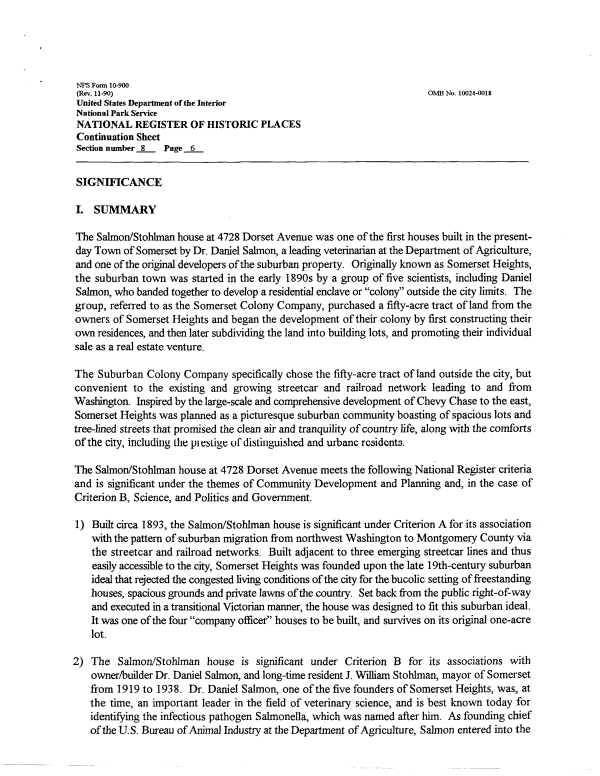 |
||||
|
DEPARTMENT OF HOUSING AND COMMUNITY DEVELOPMENT, MARYLAND HISTORICAL TRUST (Historic Sites Survey) var.d. MSA SE16-5 Image No: se16-5-0232 Enlarge and print image (74K) |
 |
||||
|
DEPARTMENT OF HOUSING AND COMMUNITY DEVELOPMENT, MARYLAND HISTORICAL TRUST (Historic Sites Survey) var.d. MSA SE16-5 Image No: se16-5-0232 Enlarge and print image (74K) |
| NFS Foim 10-900 (Rev. 11-90) 0MB No. 10024-0018 United States Department of the Interior National Park Service NATIONAL REGISTER OF HISTORIC PLACES Continuation Sheet Section number 8 Page 6 SIGNIFICANCE I. SUMMARY The Salmon/Stohlman house at 4728 Dorset Avenue was one of the first houses built in the present-day Town of Somerset by Dr. Daniel Salmon, a leading veterinarian at the Department of Agriculture, and one of the original developers of the suburban property. Originally known as Somerset Heights, the suburban town was started in the early 1890s by a group of five scientists, including Daniel Salmon, who banded together to develop a residential enclave or "colony" outside the city limits. The group, referred to as the Somerset Colony Company, purchased a fifty-acre tract of land from the owners of Somerset Heights and began the development of their colony by first constructing their own residences, and then later subdividing the land into building lots, and promoting their individual sale as a real estate venture. The Suburban Colony Company specifically chose the fifty-acre tract of land outside the city, but convenient to the existing and growing streetcar and railroad network leading to and from Washington. Inspired by the large-scale and comprehensive development of Chevy Chase to the east, Somerset Heights was planned as a picturesque suburban community boasting of spacious lots and tree-lined streets that promised the clean air and tranquility of country life, along with the comforts of the city, including the pieslige of distinguished and urbane residents. The Salmon/Stohlman house at 4728 Dorset Avenue meets the following National Register criteria and is significant under the themes of Community Development and Planning and, in the case of Criterion B, Science, and Politics and Government. 1) Built circa 1893, the Salmon/Stohlman house is significant under Criterion A for its association with the pattern of suburban migration from northwest Washington to Montgomery County via the streetcar and railroad networks. Built adjacent to three emerging streetcar lines and thus easily accessible to the city, Somerset Heights was founded upon the late 19th-century suburban ideal that rejected the congested living conditions of the city for the bucolic setting of freestanding houses, spacious grounds and private lawns of the country. Set back from the public right-of-way and executed in a transitional Victorian manner, the house was designed to fit this suburban ideal. It was one of the four "company officer" houses to be built, and survives on its original one-acre lot. 2) The Salmon/Stohlman house is significant under Criterion B for its associations with owner/builder Dr. Daniel Salmon, and long-time resident J. William Stohlman, mayor of Somerset from 1919 to 1938. Dr. Daniel Salmon, one of the five founders of Somerset Heights, was, at the time, an important leader in the field of veterinary science, and is best known today for identifying the infectious pathogen Salmonella, which was named after him. As founding chief of the U.S. Bureau of Animal Industry at the Department of Agriculture, Salmon entered into the |